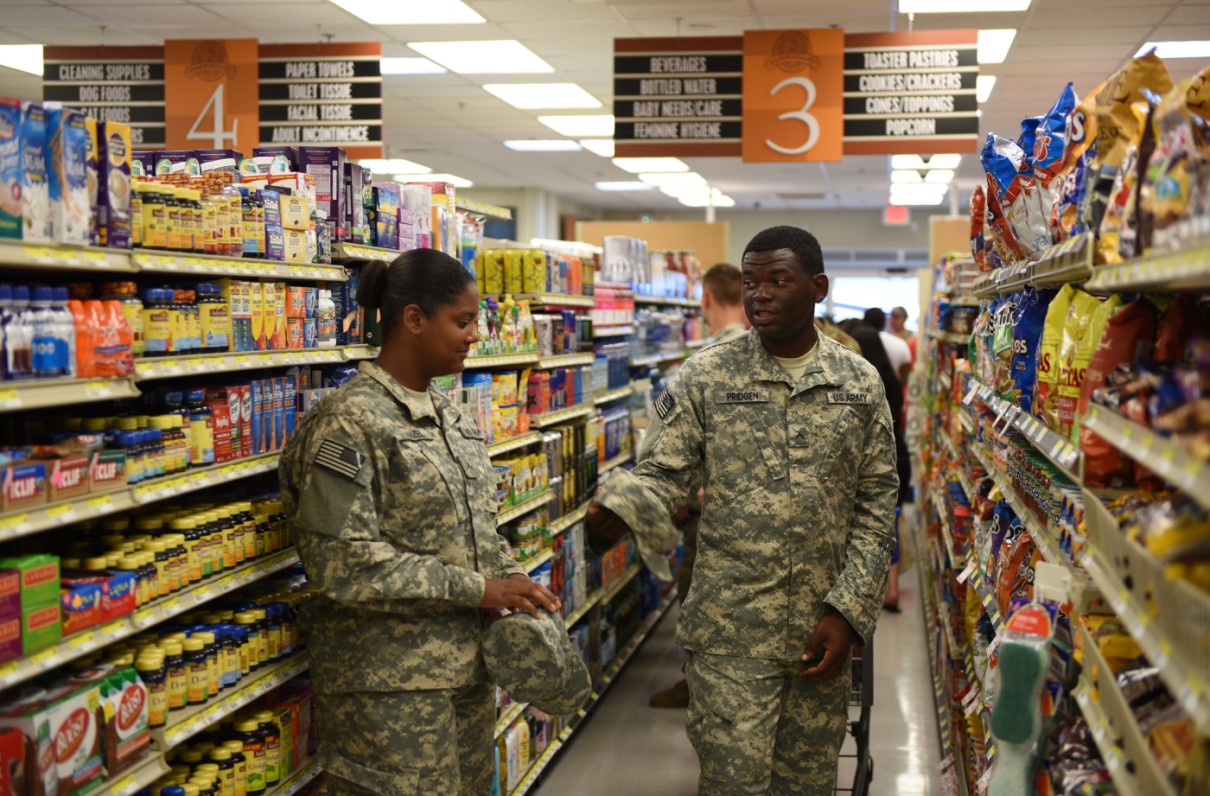This article by Karen Jowers originally appeared on Military Times, the nation's largest independent newsroom dedicated to covering the military and veteran community.
As about 3 million more people will soon be eligible to shop at military stores, officials are working to make sure these new customers will have access to bases, and that the shelves will be stocked.
Starting Jan. 1, all service-connected disabled veterans, Purple Heart recipients, former prisoners of war and primary veteran caregivers will be eligible to shop at commissaries and exchanges, and officials from three federal agencies are preparing the way.
The newly eligible customers will also be able to use certain morale, welfare and recreation activities.
It’s the largest patronage expansion in more than 60 years, said Virginia Penrod, principal deputy assistant secretary of defense for manpower and reserve affairs, who spoke at a recent meeting of the American Logistics Association.
The departments of Defense, Veterans Affairs, and Homeland Security have been planning for the expansion for more than six months, with four teams totaling about 70 people. Among other things, they’ve decided how the new customers will get access to military installations and to the stores; assessed the impact on the stores, and have been making plans to ensure enough products get to the shelves in the right assortment.
The fiscal 2019 National Defense Authorization Act expanded the pool of eligible shoppers. Because the expansion also applies to Coast Guard facilities, the Department of Homeland Security has been involved.
[RELATED: Widows Tax Repeal, 3.1% Pay Raise, and More Move Forward as House Passes Defense Bill]
The law also included Medal of Honor recipients, but they already had shopping privileges. Previously, veterans with 100 percent service-connected disabilities were able to shop; now all with service-connected disabilities can shop. The benefit extends to MWR programs that are “revenue-generating facilities,” according to the law.
The expansion is about a 50 percent increase in customers. Currently, about 6 million total households are eligible for the benefit; this adds 3 million, said Justin Hall, director of the DoD office of MWR and Resale Policy. “That’s a huge lift across the entire system.” he said.
Officials have been mapping out the areas, using VA statistics, where there may be more of an impact on the stores. The impact assessments generally show there will be a low to moderate impact on military stores overall, said Penrod. But she called on representatives of industry for their help to make sure the supply chain “remains responsive to the increased sales volume to ensure no out of stock situations occur” at stores in states with high populations of disabled veterans and in states with higher cost of living.
States with a higher population density of disabled veterans are Florida, Texas and California, said Barry Patrick, in the DoD office of resale policy. High cost areas were identified as Hawaii; Alaska, California; the Washington metropolitan area; New York; New Jersey and Washington state, he said.
These new shoppers generally don’t have access to military bases. Officials have decided that the best form of identification for these groups:
- Disabled and other eligible veterans: For access into the installation, and for access to the stores, they’ll use the veterans health ID card, Patrick said. Officials are working to enable technology at the front gate to scan those veteran cards, and will start scanning the cards in October, he said. Commissary officials are working on adjusting their technology to enable systems to read the veterans health ID card.
- Caregivers: The process will be different, initially, Patrick said, since they’re not directly affiliated with DoD or VA other than through their annual appointment to be a caregiver. The benefit applies to the primary caregiver of wounded/injured veterans who are registered in the Department of Veterans Affairs caregiver program. Beginning in October, the VA will post a memo to VA.gov for caregivers, to be used for access at the front gate, along with driver’s license or other authorized form of ID. The VA process will later transition to a caregiver-type ID card, which will have scanning swipe capability, he said.
Currently there are about 30,000 VA caregivers who will qualify for this benefit, but over the next several years the number could potentially grow to about 250,000, Patrick noted.
[RELATED: MOAA's Tips for Lifelong Caregiving]
Credit Card Fee
These new customers will pay a fee for using a credit card at commissaries, except for the military resale system’s Military Star card. The amount of the fee has not yet been determined. By law, this expansion can’t include extra costs associated with using credit cards in commissaries; the cost must be passed on to the customer. Except for the Military Star card, credit card companies charge transaction fees to retailers when customers use their credit cards.
There will be a flag built into the system at commissaries so that when the card is swiped the fee will be charged.
The fee applies only to new patrons using credit cards in commissaries, not to Medal of Honor recipients or others who were previously authorized to shop. New customers can avoid the fees by paying by cash, check or using the Military Star card. It only applies at the commissary, which is funded primarily by taxpayer dollars.
The DoD resale community has been working together to estimate the number of likely shoppers by location, and the merchandise categories that will interest those shoppers. For example, the Army and Air Force Exchange Service will be adjusting its inventory by location, said Chris Ward, spokesman for AAFES. “Extending the brick-and-mortar military exchange benefit to all disabled veterans is not expected to require material investments in facilities or technology,” he said.
Patrick said officials will launch an information campaign to get out the word about the new benefit to the new customers, but also to installation officials.
Other articles by Military Times:
Air Force halts millions in management incentive payments to military housing provider amid misconduct allegations
This proposal would give more money to military families struggling to put food on the table
Fort Hood soldiers respond to fiery truck crash on base



